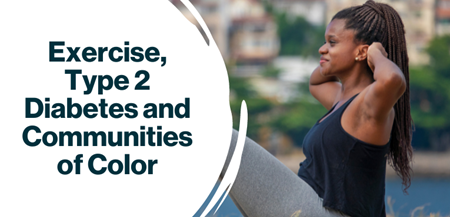Sheri Colberg, Ph.D., and Jill Kanaley, Ph.D., FACSM |
Feb.
15, 2022
 ACSM’s February release of its new consensus statement on type 2 diabetes (T2D) and physical activity is timely for Black History Month 2022 — communities of color disproportionately bear the burden of overweight/obesity and diabetes, likely due in large part to social and environmental factors. For instance, we know that a reduction in physical education offerings in schools, limited open spaces for outdoor activities, inadequate infrastructure for active transportation, unsafe environments and high-calorie diets all have a big impact on the development of T2D.
ACSM’s February release of its new consensus statement on type 2 diabetes (T2D) and physical activity is timely for Black History Month 2022 — communities of color disproportionately bear the burden of overweight/obesity and diabetes, likely due in large part to social and environmental factors. For instance, we know that a reduction in physical education offerings in schools, limited open spaces for outdoor activities, inadequate infrastructure for active transportation, unsafe environments and high-calorie diets all have a big impact on the development of T2D.
For black communities, then, a main focus should be on building neighborhoods that promote physical activity: increasing walkability by having pleasant and safe places to walk, making resources and facilities for activity more available to all and enhancing access to green spaces, especially for people who live in urban settings. Creating more exercise-friendly environments is likely to promote greater participation.
Community members, exercise and health care professionals and policymakers need to address a few other obstacles and barriers to physical activity: specific efforts should support self-motivation, assist in appropriate physical activity and dietary goal-setting, give people access to childcare while they’re being active and enhance social support while being respectful of cultural nuances.
Additionally, for many people, health issues such as obesity and osteoarthritis may make physical activity more difficult. Tailoring fitness goals using appropriate activities, slower progression and supportive feedback/supervision can increase their success and confidence.
The consensus statement, relevant for people of all ages, suggests that anyone with T2D should engage in regular physical activity and reduce their daily sedentary time. Lifestyle interventions that include physical activity and possible weight loss remain important approaches in the management of T2D and cardiovascular disease risk in communities of color. Various types of physical activity and planned exercise can greatly enhance health and blood glucose management.
Read the new consensus statement here.
6 Tips for Physical Activity with Type 2 Diabetes | Infographic
Sheri Colberg, Ph.D., is an author, lecturer, consultant, researcher, exercise physiologist, and professor emerita of exercise science from Old Dominion University.
Jill Kanaley, Ph.D., FACSM, is a professor in and interim director of the Department of Nutrition and Exercise at the University of Missouri. Both Colberg and Kanaley are corresponding authors for “Exercise/Physical Activity in Individuals with Type 2 Diabetes: A Consensus Statement from the American College of Sports Medicine.”